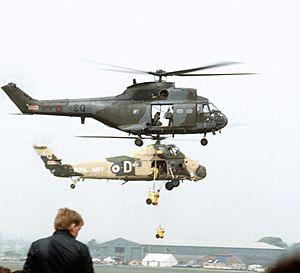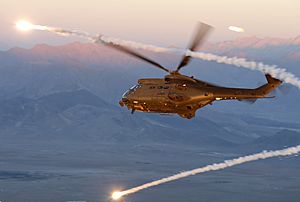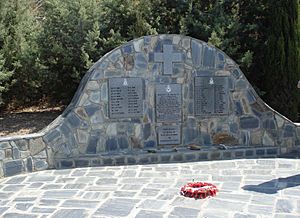No. 33 Squadron RAF facts for kids
Quick facts for kids No. 33 Squadron RAF |
|
|---|---|

Squadron badge
|
|
| Active | 12 January 1916 – 1 April 1918 (RFC) 1 April 1918 – 13 June 1919 (RAF) 1 March 1929 – 31 March 1955 15 December 1955 – 3 June 1957 30 September 1957 – 17 December 1962 1 March 1965 – 30 January 1970 14 June 1971 – present |
| Country | |
| Branch | |
| Type | Flying squadron |
| Role | Helicopter medium-lift support |
| Part of | Joint Helicopter Command |
| Home station | RAF Benson |
| Motto(s) | Loyalty |
| Aircraft | Westland Puma HC2 |
| Battle honours | |
| Commanders | |
| Officer Commanding | Wg Cdr S P Fletcher MVO MA RAF |
| Notable commanders |
Hector McGregor (Sep 1938 – Jan 1940) Marmaduke Pattle (Mar – Apr 1941) |
| Insignia | |
| Squadron badge heraldry | A hart's head affrontée, couped at the neck, developed from an unofficial emblem produced in the early 1930s when the squadron introduced the famous Hawker Hart into service. Approved by King Edward VIII in May 1936. |
| Squadron Roundel |  |
| Squadron codes | SO (Sep 1938 – May 1939) TN (May 1939 – Sep 1939) NW (Sep 1939 – May 1941) 5R (Apr 1944 – Apr 1951) CA–CZ (Pumas) |
No. 33 Squadron is a special flying unit of the Royal Air Force (RAF). It uses Westland Puma HC.2 helicopters. The squadron is based at RAF Benson in Oxfordshire, England. Its motto is Loyalty.
Contents
History
Early Years and World War I
No. 33 Squadron started on 12 January 1916. It was part of the Royal Flying Corps (RFC) during the First World War. Its main job was to protect England from German airship attacks. The squadron flew planes like the Royal Aircraft Factory BE.2 and Royal Aircraft Factory FE.2. Later, they used Bristol Fighters and Avro 504s. Even though they tried, they didn't shoot down any enemy airships. The squadron was closed down in June 1919 after the war ended.
Between the World Wars
The squadron was restarted on 1 March 1929. It became a bomber unit, first flying the Hawker Horsley. In February 1930, it was the first squadron to get the new Hawker Hart aircraft. This plane was so fast it could outrun the RAF's fighter planes! In 1935, the squadron moved to Egypt. They helped keep peace in Palestine. In 1938, they switched to Gloster Gladiators and became a fighter squadron.
World War II Operations
During most of World War II, No. 33 Squadron stayed in the Middle East. They used their Gloster Gladiators to fight. On 14 June 1940, they shot down their first enemy planes. This happened while they were helping British forces capture Fort Capuzzo. They later got faster Hurricanes to fight Italian bombers.
In January 1941, the squadron went to Greece to help stop the Italian invasion. A famous pilot named Pat Pattle led the squadron for a short time. He was a top flying ace. The squadron faced heavy fighting when Germany joined the battle. They had to move to Crete. Due to many losses, the squadron joined with another unit. Their ground crew even fought German paratroopers to protect their airfield. The remaining members of 33 Squadron returned to Egypt in May 1941.
The squadron then went back to help the army in the desert. They fought in important battles like the Second Battle of El Alamein. In December 1943, they started flying Spitfires.
In 1944, the squadron returned to the UK. They helped with Operation Overlord, the Allied invasion of Normandy. They flew fighter planes on D-Day (6 June 1944). Later, they moved to France and focused on attacking enemy targets on the ground. In December, they got Hawker Tempest planes. They continued flying fighter missions in Europe. The squadron stayed in Germany until 1949.
After World War II
From 1949 to 1970, No. 33 Squadron was often in the Far East. They were based in Hong Kong and then Malaya. In Malaya, they used their Tempests to attack Communist rebels. In 1951, they started flying de Havilland Hornet planes. The squadron flew over 6,000 missions in Malaya before it was temporarily closed in March 1955.
The squadron reformed in December 1955 as a night fighter unit. They flew de Havilland Venom and Gloster Meteor planes. They later used Gloster Javelins. The squadron was closed and reformed several times in the 1950s and 1960s. In April 1965, No. 33 Squadron became a unit that used Bristol Bloodhound surface-to-air missiles. It was closed again in January 1970.
The squadron reformed on 14 June 1971. It became the RAF's first unit to fly Westland Puma helicopters. They took part in the Gulf War in 1991. They also helped in the Kosovo War in the late 1990s. In 2000, they assisted with flood relief in Mozambique. They also supported NATO operations in Bosnia in the early 2000s.
In August 2007, a Puma helicopter from No. 33 Squadron crashed. Three people died in the accident. Investigations into the crash followed. The squadron was sent to Iraq in 2009 as part of Operation Telic.
The older Puma HC.1 helicopters were replaced by the newer Puma HC.2 in December 2012.
In October 2015, a squadron member died in an accident in Kabul, Afghanistan. The Ministry of Defence said it was an accident, not an attack. The pilot was remembered for his loyalty and dedication to his job. Investigations into this accident were also carried out.
Aircraft Used
This table shows the different aircraft flown by No. 33 Squadron over the years.
| From | To | Aircraft | Version |
|---|---|---|---|
| Jan 1916 | Nov 1916 | Royal Aircraft Factory B.E.2 | |
| Nov 1916 | Jun 1918 | Royal Aircraft Factory F.E.2 | |
| Jun 1918 | Aug 1918 | Bristol F.2 Fighter | |
| Aug 1918 | Jun 1919 | Avro 504 | |
| Mar 1929 | Feb 1930 | Hawker Horsley | |
| Feb 1930 | Feb 1938 | Hawker Hart | |
| Feb 1938 | Oct 1940 | Gloster Gladiator | |
| Sep 1940 | Dec 1943 | Hawker Hurricane | |
| Feb 1943 | Dec 1944 | Supermarine Spitfire | |
| Dec 1944 | Nov 1945 | Hawker Tempest | Tempest V |
| Nov 1945 | 1946 | Supermarine Spitfire | |
| 1946 | 1951 | Hawker Tempest | Tempest F.2 |
| 1951 | Mar 1955 | de Havilland Hornet | |
| Oct 1955 | Jun 1957 | de Havilland Venom | NF.2 |
| Oct 1955 | Jan 1957 | Gloster Meteor | NF.14 |
| Jul 1958 | Nov 1962 | Gloster Javelin | FAW.7 |
| March 1965 | Jan 1970 | Bristol Bloodhound | (Missile) |
| June 1971 | Dec 2012 | Westland Puma | HC.1 |
| Sep 2012 | Date | Westland Puma | HC.2 |
Memorials
There is a special memorial in Crete for the airmen of No. 30 and No. 33 Squadrons. These brave airmen died during the Battle of Crete. The memorial is located near the Iron Bridge across the Tavronitis River. It is also close to the end of the Maleme Airport runway.
See also
- List of RAF squadrons




